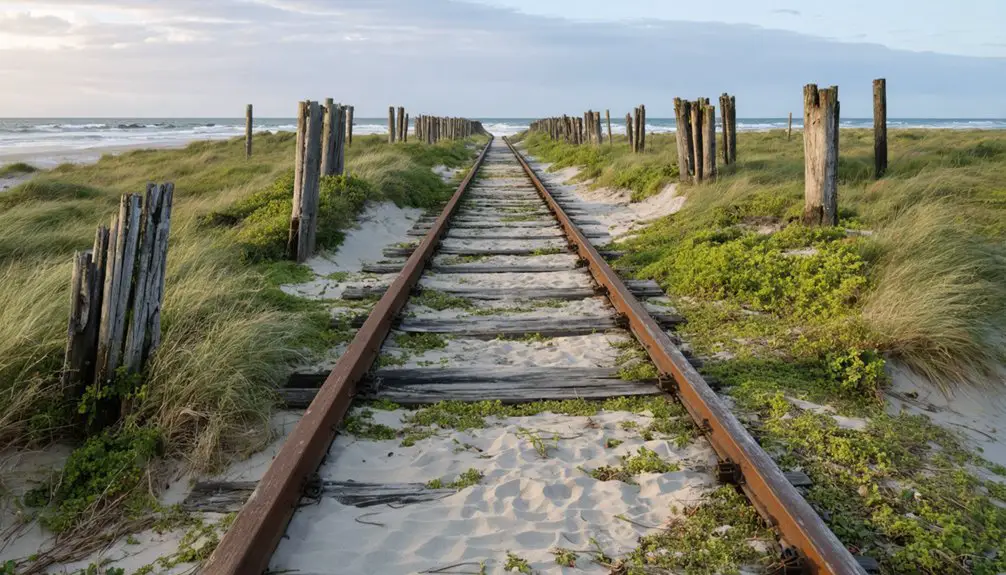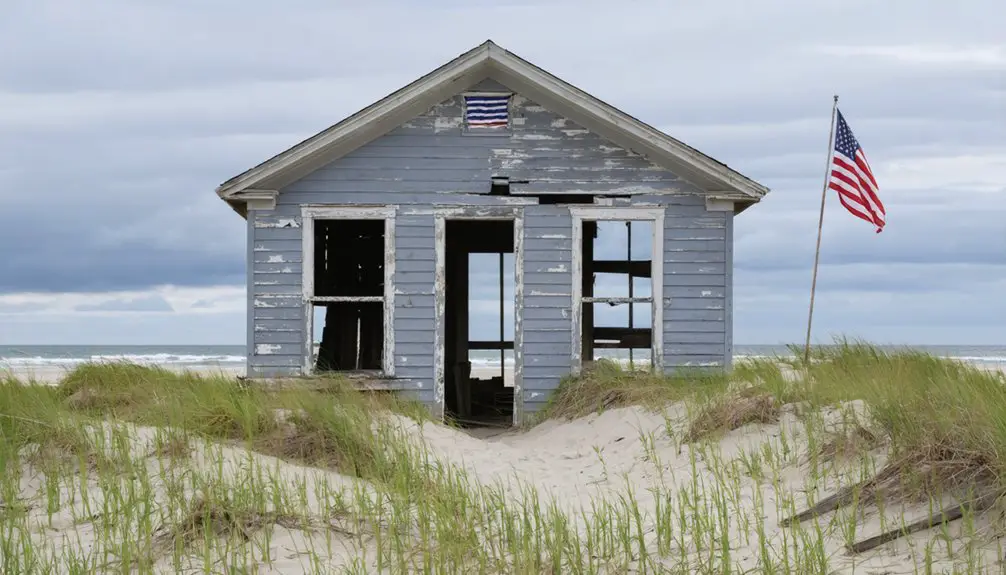You’ll discover Island Beach’s transformation from a bustling 1890s resort destination to an abandoned coastal community. The area’s storied past includes pirates using hidden coves, the legendary Warner House hotel that burned in 1890, and devastating storms that reshaped the shoreline. Rising sea levels and coastal erosion have claimed numerous structures, while the 1946 bridge fire ended essential rail connections. The ghostly remains hold countless untold tales of this once-thriving paradise.
Key Takeaways
- The once-thriving Warner House hotel, built in 1836 and destroyed by fire in 1890, marked the beginning of Island Beach’s decline.
- Devastating storms, including Hurricane Sandy in 2012, destroyed hundreds of homes and reshaped the coastal landscape significantly.
- The 1946 fire that damaged the bridge ended Philadelphia rail service, isolating the area and contributing to its abandonment.
- Coastal erosion claims approximately 2 feet of shoreline annually, forcing many residents to abandon their beachfront properties.
- The Great Depression disrupted Henry Phipps’ 1926 plans to create an exclusive resort, halting major development in the area.
The Rise of a Coastal Paradise
While the pristine beaches of Island Beach remained largely untouched through most of the colonial period, its origins can be traced to a 17th-century land grant to William Alexander, the Earl of Stirling, under English rule.
The Lenape tribes inhabited and used these shores seasonally for fishing and gathering before European settlement began.
You’ll find this narrow peninsula strategically positioned between the Atlantic Ocean and Barnegat Bay, just 72 miles from New York City and 53 miles from Philadelphia.
Early coastal development was minimal, with land values so low that an 1790 sheriff’s notice listed parcels at merely £0.06.
Land prices in the area were remarkably cheap during colonial times, with shorefront lots selling for pennies at sheriff’s auctions.
The first signs of urban migration appeared in the 1890s when Sea Shore Realty Co. launched an ambitious “Cottage City” project, selling 25×100 ft lots.
Though over 100 modest structures eventually dotted the landscape, the area maintained its wild character, defying the typical pattern of rapid seaside development.
In 1926, Henry Phipps acquired the property with grand visions of transforming it into an exclusive seaside resort, though his plans were ultimately thwarted by the Great Depression.
Maritime Heritage and Pirate Tales
You’ll discover scattered remnants of hidden coves and inlets along Island Beach where pirates once anchored their vessels during the Revolutionary War, particularly near the strategic Cranberry Inlet.
These natural harbors served dual purposes – offering safe haven for privateers commissioned by the Continental Congress while facilitating their disruption of British maritime trade routes.
Ship pilots familiar with these treacherous waters played a vital role in guiding both legitimate vessels and pirate ships through the challenging coastal passages, establishing a legacy that would influence the area’s maritime development for generations.
The early maritime history continued well into the 1800s when the Life Saving Station #20 was established to rescue stranded vessels and sailors in distress. Today, exhibits at the New Jersey Maritime Museum preserve evidence of this rich nautical heritage through salvaged artifacts and shipwreck documentation.
Hidden Pirate Anchorage Sites
During the late 1600s and early 1700s, Island Beach’s intricate network of waterways served as a strategic haven for pirates and privateers seeking refuge along the New Jersey coast.
You’ll find that the shallow waters and hidden inlets, particularly the historic Cranberry Inlet, provided perfect pirate hideouts where smaller vessels could easily evade larger naval ships. Similar to the pirates who flew English colors to deceive coastal residents, these waterways enabled deceptive tactics.
These natural harbors weren’t just anchorage points – they were gateways to illicit trade. Pirates would slip into Barnegat Bay’s protected waters to unload their plundered cargo and bury hidden treasures along secluded beaches. Much like the infamous Blackbeard’s raid, these waters attracted notorious pirates seeking strategic locations for their operations.
The complex geography of barrier islands and tidal systems created an ideal environment for clandestine operations. Even Captain Kidd himself utilized these waters, taking advantage of the area’s remote nature and limited colonial surveillance to conduct his notorious raids.
Historical Ship Pilot Legacy
Maritime expertise flourished among early settlers and baymen of Island Beach, who mastered the art of steering through Barnegat Bay‘s treacherous waters by the mid-19th century.
You’ll find their pilot traditions woven into the area’s rich history, as these skilled navigators guided vessels past dangerous shoals and shifting sandbars that claimed over 4,800 ships. The area’s historical significance is preserved at the New Jersey Maritime Museum in Beach Haven. The museum’s extensive collection of diving artifacts helps tell the story of maritime exploration and rescue efforts.
The 163-foot Barnegat Lighthouse became these pilots’ significant ally, helping them safely escort both commercial vessels and pleasure craft through one of the Eastern Seaboard’s most challenging maritime regions.
Local pilots’ deep knowledge proved essential for the growing tourism industry, as they ferried sportsmen to prime hunting and fishing spots.
The area’s countless shipwreck stories, from the Morro Castle disaster to the Andrea Doria collision, underscore why skilled pilots were so important to maritime safety.
Tales of the Haunted Shore
Along the misty shores of Island Beach, tales of supernatural occurrences have shaped local folklore for generations.
You’ll discover a rich tapestry of ghostly encounters and maritime folklore, from phantom pirates to the spirits of shipwrecked souls. The transformation brought by the Cape May Canal’s construction in the 1940s stirred up more than just sand – it awakened stories of the past that refuse to rest. During World War II, the canal was built to protect ships from German U-boat attacks. Some say the most haunting presence comes from the Warner House hotel, where ghostly guests still check in nightly.
Ancient spirits stir beneath Island Beach’s sands, where phantom mariners and lost souls whisper tales of storms long past.
- The mysterious figure that appears on foggy summer nights near Joseph Higby’s grave
- Cold spots and unexplained singing at the Surf City Hotel
- The terror-stricken woman and baby seen gazing from upper windows
- Sorrowful cries of drowned passengers that blend with the ocean’s waves
These haunting tales continue to captivate visitors, weaving together the natural and supernatural elements of Island Beach’s coastal history.
Natural Forces and Environmental Impact
You’ll find Island Beach State Park’s shoreline dramatically altered by relentless coastal erosion, with powerful storms washing away beaches and decimating coastal communities that once thrived here.
Rising sea levels and intensifying weather patterns continue to reshape the barrier island’s 3,000 acres, threatening both wildlife habitats and remaining infrastructure.
The park’s natural defenses – its maritime forests and dune systems – fight a constant battle against storm surges and flooding, but climate change has accelerated the destructive impact of these forces on this vulnerable ecosystem.
Coastal Erosion’s Devastating Toll
The devastating forces of coastal erosion have systematically reshaped Island Beach’s shoreline, with surveys since 1986 revealing consistent sand loss and dune deterioration.
You’ll find that coastal management efforts and erosion prevention strategies haven’t been enough to combat the relentless assault of waves and storms on this vulnerable coastline.
- Your beach is disappearing at roughly 2 feet per year, which means a staggering 120-foot loss over six decades.
- You’re witnessing dunes as high as 11 feet failing to protect against major storms.
- You’ll see how massive hurricanes have stripped tens of thousands of cubic yards of sand.
- Your local environment’s suffering includes disrupted offshore bars and degraded wetlands.
This persistent erosion threatens not just property, but the entire ecosystem’s survival, making traditional coastal living increasingly precarious.
Rising Waters Reshape Shoreline
Rising seas pose an unprecedented threat to Island Beach’s fragile shoreline, with local water levels climbing at more than twice the global average since the early 1900s.
You’ll witness dramatic shoreline changes as rising tides push inland, permanently reshaping beaches, bays, and barrier islands that have defined this coast for generations.
The impact extends beyond visible changes.
You’re looking at a shore where marsh drowning disrupts critical sand replenishment, while existing development prevents natural inland migration of coastal habitats.
Despite efforts to raise beach dunes up to 16 feet high, the relentless advance of water creates a “coastal squeeze” that’s steadily eliminating intertidal zones.
What you’re seeing isn’t just erosion – it’s a fundamental transformation of Island Beach’s geography that threatens both its natural character and human infrastructure.
Storms Destroy Beach Communities
Since the early 1900s, devastating storms have repeatedly battered Island Beach’s barrier islands, with Hurricane Sandy delivering the most catastrophic blow in 2012 when it destroyed over 346,000 New Jersey homes and claimed 38 lives.
You’ll find the storm devastation has permanently altered these coastal communities, where storm surge and powerful waves have redrawn the shoreline.
Despite their community resilience, many residents faced overwhelming losses:
- Sandy’s surge uprooted a 40-foot barge buried since 1992, pushing it half a mile inland.
- Mantoloking lost two dozen oceanfront houses to complete destruction.
- Long Beach Island’s streets disappeared under four feet of sand.
- The 1962 nor’easter nearly erased two blocks of Holgate’s beachfront, with debris remaining in the bay for years.
The Warner House Legacy
Built in 1836 by New York attorney Henry Whiting Warner, the Warner House evolved from an eight-room family dwelling into one of Sea Breeze’s most significant landmarks.
Using remnants of a Revolutionary War barracks as its foundation, the property transformed into a luxurious 40-room resort hotel by 1887, offering amenities like bathing, billiards, and bowling.
The Warner House’s cultural significance extended beyond hospitality. Warner’s daughters, Susan and Anna, hosted Bible classes for West Point cadets who affectionately called themselves “Miss Warner’s Boys.”
The hotel became the social heart of Sea Breeze, hosting clambakes and boat races while serving steamboat passengers from Philadelphia.
Though destroyed by fire in 1890, the Warner House’s legacy lives on as a symbol of Sea Breeze’s golden age of prosperity and community gathering.
Transportation Hub and Tourism

Before railroad development transformed Island Beach into a bustling tourist destination, stagecoaches carried early visitors to the shore for 87½ cents per trip.
You’ll discover how this transportation evolution revolutionized access when the Toms River & Barnegat Railroad arrived in 1882, connecting Ocean Gate to Seaside Park across Barnegat Bay.
The tourism transformation brought dramatic changes to the peninsula:
- Primitive accommodations for hardy sportsmen evolved into established resorts like Reed and Haring Hotels.
- Sea Shore Realty Co. marketed “Cottage City” in the 1890s, promoting pristine white sand beaches.
- Local baymen became guides for recreational hunters and fishermen.
- Railroad freight services transported fresh catch to Philadelphia markets, boosting the local economy.
This crucial rail connection served the region until a devastating 1946 fire damaged the bridge, ending Philadelphia rail service by 1948.
The Path to Abandonment
The steady erosion of Island Beach’s community began long before its final abandonment, as natural forces and economic challenges gradually dismantled the once-thriving resort town.
You’d have witnessed multiple abandonment factors converge: rising sea levels, devastating storms, and saltwater intrusion made maintaining infrastructure nearly impossible.
The collapse of the local economy accelerated when transportation routes diminished, cutting off crucial tourist access.
Economic shifts favored more accessible coastal locations, while the construction of the Cape May Canal in the 1940s dealt another blow, forcing demolition of existing properties.
You can trace the town’s decline through the disappearance of hotels, businesses, and summer rentals.
The younger generation’s exodus to urban centers, combined with changing social habits, ultimately sealed Island Beach’s fate as visitors sought out more convenient destinations.
Exploring the Ghost Town Today
Modern-day visitors to Island Beach State Park can explore the haunting remnants of this once-vibrant coastal community through carefully maintained trails and designated access points.
Your ghost town exploration journey reveals scattered ruins reclaimed by nature, where foundations and stone walls tell stories of the past.
Time stands frozen in these weathered ruins, where crumbling foundations whisper secrets of lives once lived along the shore.
- You’ll find interpretive signs marking historical remnants throughout the park, though coastal erosion has claimed some structures.
- The best time to visit is during summer months when facilities are fully operational until 6 PM.
- You can join seasonal ghost tours featuring tales of shipwrecks and spirits near the former townsite.
- Be prepared for uneven terrain and wildlife encounters while traversing the historical sites, and remember to follow park preservation rules that protect these precious ruins.
Frequently Asked Questions
Are There Any Remaining Structures From the Original Island Beach Settlement?
You’ll find few architectural remnants today, with the Judge’s Shack, built in 1911, standing as the main historic preservation success among the original settlement’s once-numerous fishing and hunting structures.
What Happened to the Residents When They Abandoned Island Beach?
You’ll find that residents either relocated to nearby urban areas or suburban communities, following residential relocation patterns typical of ghost town history, seeking better economic opportunities and safer living conditions.
Can Visitors Swim or Fish at Island Beach Today?
Like waves rolling in, you’ll find both swimming and fishing opportunities at Island Beach. You can swim during summer with lifeguards (10am-6pm) and fish outside guarded hours, following park regulations.
Were There Any Notable Shipwrecks Near Island Beach?
You’ll find rich shipwreck history along these waters, including the Gulftrade’s tragic 1886 sinking that claimed eleven lives and the Persephone’s 1942 U-boat attack—both adding to compelling maritime tales.
Did Any Native American Tribes Inhabit Island Beach Before European Settlement?
You’ll discover the Lenape Native tribes were the original inhabitants, establishing both permanent and seasonal camps along the shore. Their cultural impact remains visible through shell middens and place names they left behind.
References
- https://www.youtube.com/watch?v=5uUtuI6A5DE
- https://thedigestonline.com/new-jersey/the-forgotten-beach-town-of-nj-sea-breeze/
- https://wpst.com/abandoned-town-new-jersey/
- https://rsftripreporter.net/gone-goner-ghost-towns-new-jersey-pine-barrens-part/
- https://jerseydigs.com/ghost-towns-in-nj/
- https://friendsofibsp.org/wp-content/uploads/2016/10/story-of-island-beach.pdf
- https://www.thejudgesshack.org/articles/project-one-6d23y
- https://www.islandbeachnj.org/History/History.html
- https://en.wikipedia.org/wiki/Island_Beach
- https://www.thefisherman.com/article/island-beach-state-park-saved-from-steel-awarded-to-wind/



